SKODA FABIA 2009 2.G / 5J Owner's Manual
Manufacturer: SKODA, Model Year: 2009, Model line: FABIA, Model: SKODA FABIA 2009 2.G / 5JPages: 259, PDF Size: 31.99 MB
Page 151 of 259
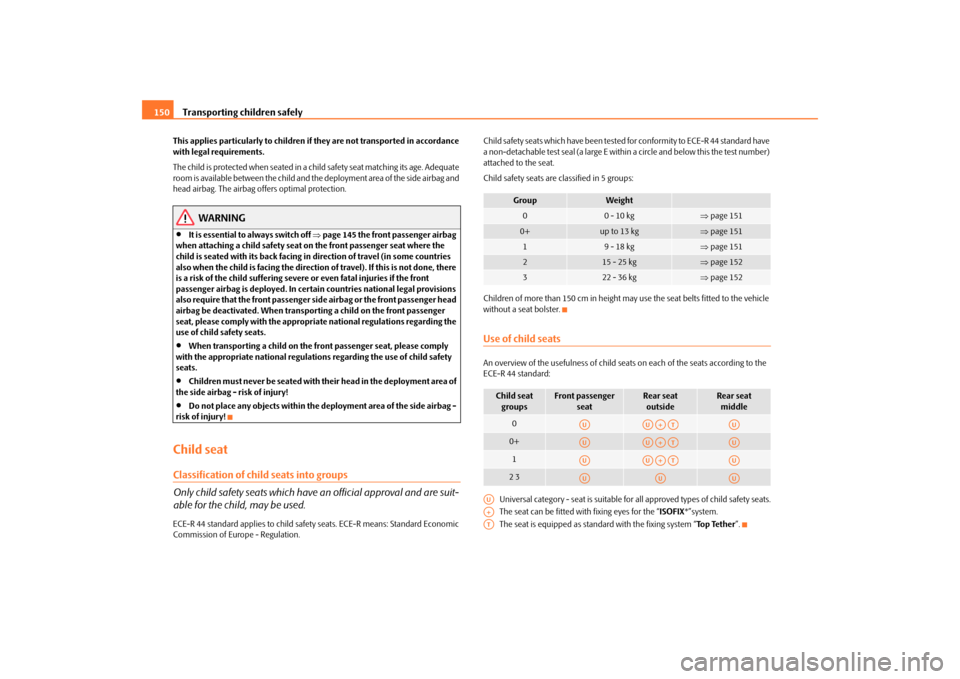
Transporting children safely 150This applies particularly to children if they are not transported in accordance
with legal requirements.
The child is protected when seated in a child safety seat matching its age. Adequate
room is available between the child and the deployment area of the side airbag and
head airbag. The airbag offers optimal protection.
WARNING
•
It is essential to always switch off ⇒page 145 the front passenger airbag
when attaching a child safety seat on the front passenger seat where the
child is seated with its back facing in direction of travel (in some countries
also when the child is facing the direction of travel). If this is not done, there
is a risk of the child suffering severe or even fatal injuries if the front
passenger airbag is deployed. In certain countries national legal provisions
also require that the front passenger side airbag or the front passenger head
airbag be deactivated. When transporting a child on the front passenger
seat, please comply with the appropriate national regulations regarding the
use of child safety seats.
•
When transporting a child on the front passenger seat, please comply
with the appropriate national regulations regarding the use of child safety
seats.
•
Children must never be seated with their head in the deployment area of
the side airbag - risk of injury!
•
Do not place any objects within the deployment area of the side airbag -
risk of injury!
Child seatClassification of child seats into groups
Only child safety seats which have an official approval and are suit-
able for the child, may be used.ECE-R 44 standard applies to child safety seats. ECE-R means: Standard Economic
Commission of Europe - Regulation.Child safety seats which have been tested for conformity to ECE-R 44 standard have
a non-detachable test seal (a large E within a circle and below this the test number)
attached to the seat.
Child safety seats are classified in 5 groups:
Children of more than 150 cm in height may use the seat belts fitted to the vehicle
without a seat bolster.
Use of child seatsAn overview of the usefulness of child seats on each of the seats according to the
ECE-R 44 standard:
Universal category - seat is suitable for all approved types of child safety seats.
The seat can be fitted with fixing eyes for the “ISOFIX*”system.
The seat is equipped as standard with the fixing system “To p Te t h e r”.
Group
Weight
0
0 - 10 kg
⇒page 151
0+
up to 13 kg
⇒page 151
1
9 - 18 kg
⇒page 151
2
15 - 25 kg
⇒page 152
3
22 - 36 kg
⇒page 152
Child seat
groups
Front passenger
seat
Rear seat
outside
Rear seat
middle
0
0+
1
2 3
AU
AUA+AT
AU
AU
AUA+AT
AU
AU
AUA+AT
AU
AU
AU
AU
AUA+AT
s3f4.1.book Page 150 Thursday, June 18, 2009 11:07 AM
Page 152 of 259
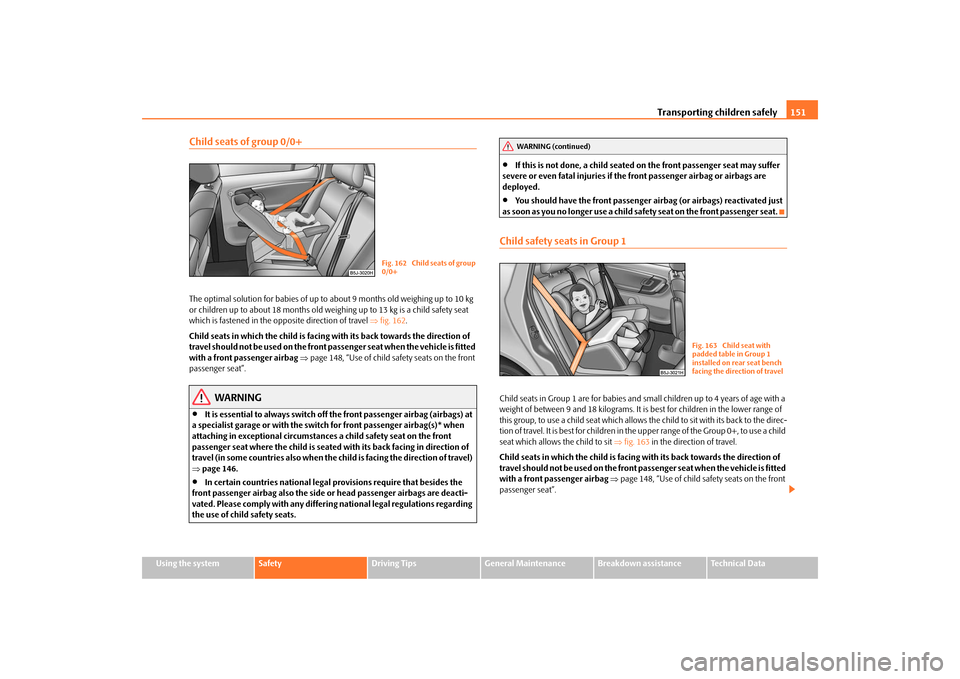
Transporting children safely151
Using the system
Safety
Driving Tips
General Maintenance
Breakdown assistance
Technical Data
Child seats of group 0/0+The optimal solution for babies of up to about 9 months old weighing up to 10 kg
or children up to about 18 months old weighing up to 13 kg is a child safety seat
which is fastened in the opposite direction of travel ⇒fig. 162.
Child seats in which the child is facing with its back towards the direction of
travel should not be used on the front passenger seat when the vehicle is fitted
with a front passenger airbag ⇒page 148, “Use of child safety seats on the front
passenger seat”.
WARNING
•
It is essential to always switch off the front passenger airbag (airbags) at
a specialist garage or with the switch for front passenger airbag(s)* when
attaching in exceptional circumstances a child safety seat on the front
passenger seat where the child is seated with its back facing in direction of
travel (in some countries also when the child is facing the direction of travel)
⇒page 146.
•
In certain countries national legal provisions require that besides the
front passenger airbag also the side or head passenger airbags are deacti-
vated. Please comply with any differing national legal regulations regarding
the use of child safety seats.
•
If this is not done, a child seated on the front passenger seat may suffer
severe or even fatal injuries if the front passenger airbag or airbags are
deployed.
•
You should have the front passenger airbag (or airbags) reactivated just
as soon as you no longer use a child safety seat on the front passenger seat.
Child safety seats in Group 1Child seats in Group 1 are for babies and small children up to 4 years of age with a
weight of between 9 and 18 kilograms. It is best for children in the lower range of
this group, to use a child seat which allows the child to sit with its back to the direc-
tion of travel. It is best for children in the upper range of the Group 0+, to use a child
seat which allows the child to sit ⇒fig. 163 in the direction of travel.
Child seats in which the child is facing with its back towards the direction of
travel should not be used on the front passenger seat when the vehicle is fitted
with a front passenger airbag ⇒page 148, “Use of child safety seats on the front
passenger seat”.
Fig. 162 Child seats of group
0/0+
WARNING (continued)
Fig. 163 Child seat with
padded table in Group 1
installed on rear seat bench
facing the direction of travel
s3f4.1.book Page 151 Thursday, June 18, 2009 11:07 AM
Page 153 of 259
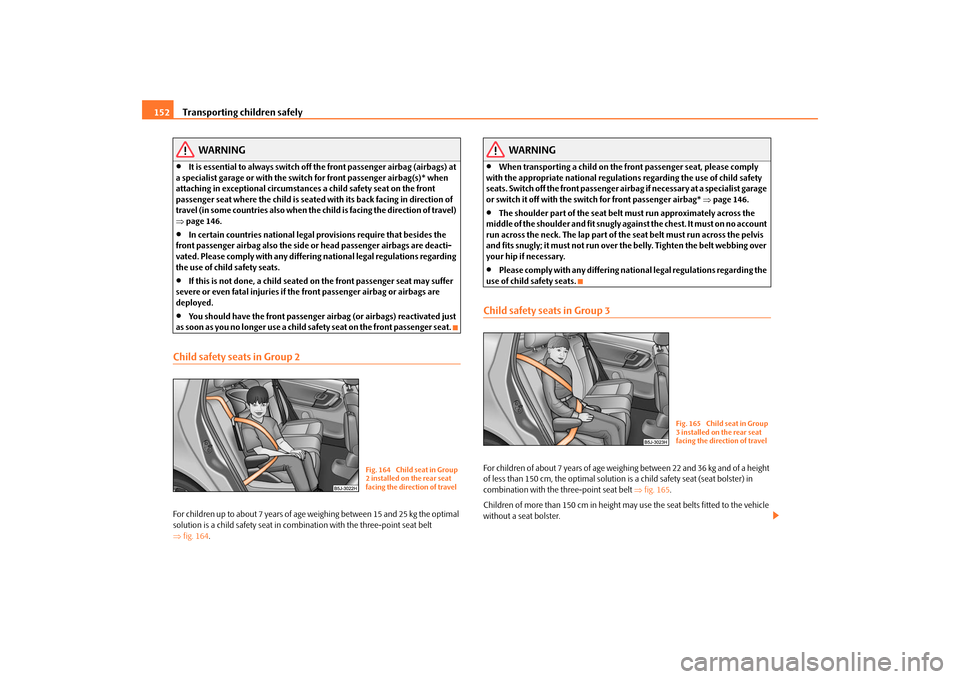
Transporting children safely 152
WARNING
•
It is essential to always switch off the front passenger airbag (airbags) at
a specialist garage or with the switch for front passenger airbag(s)* when
attaching in exceptional circumstances a child safety seat on the front
passenger seat where the child is seated with its back facing in direction of
travel (in some countries also when the child is facing the direction of travel)
⇒page 146.
•
In certain countries national legal provisions require that besides the
front passenger airbag also the side or head passenger airbags are deacti-
vated. Please comply with any differing national legal regulations regarding
the use of child safety seats.
•
If this is not done, a child seated on the front passenger seat may suffer
severe or even fatal injuries if the front passenger airbag or airbags are
deployed.
•
You should have the front passenger airbag (or airbags) reactivated just
as soon as you no longer use a child safety seat on the front passenger seat.
Child safety seats in Group 2For children up to about 7 years of age weighing between 15 and 25 kg the optimal
solution is a child safety seat in combination with the three-point seat belt
⇒fig. 164.
WARNING
•
When transporting a child on the front passenger seat, please comply
with the appropriate national regulations regarding the use of child safety
seats. Switch off the front passenger airbag if necessary at a specialist garage
or switch it off with the switch for front passenger airbag* ⇒page 146.
•
The shoulder part of the seat belt must run approximately across the
middle of the shoulder and fit snugly against the chest. It must on no account
run across the neck. The lap part of the seat belt must run across the pelvis
and fits snugly; it must not run over the belly. Tighten the belt webbing over
your hip if necessary.
•
Please comply with any differing national legal regulations regarding the
use of child safety seats.
Child safety seats in Group 3For children of about 7 years of age weighing between 22 and 36 kg and of a height
of less than 150 cm, the optimal solution is a child safety seat (seat bolster) in
combination with the three-point seat belt ⇒fig. 165.
Children of more than 150 cm in height may use the seat belts fitted to the vehicle
without a seat bolster.
Fig. 164 Child seat in Group
2 installed on the rear seat
facing the direction of travel
Fig. 165 Child seat in Group
3 installed on the rear seat
facing the direction of travel
s3f4.1.book Page 152 Thursday, June 18, 2009 11:07 AM
Page 154 of 259
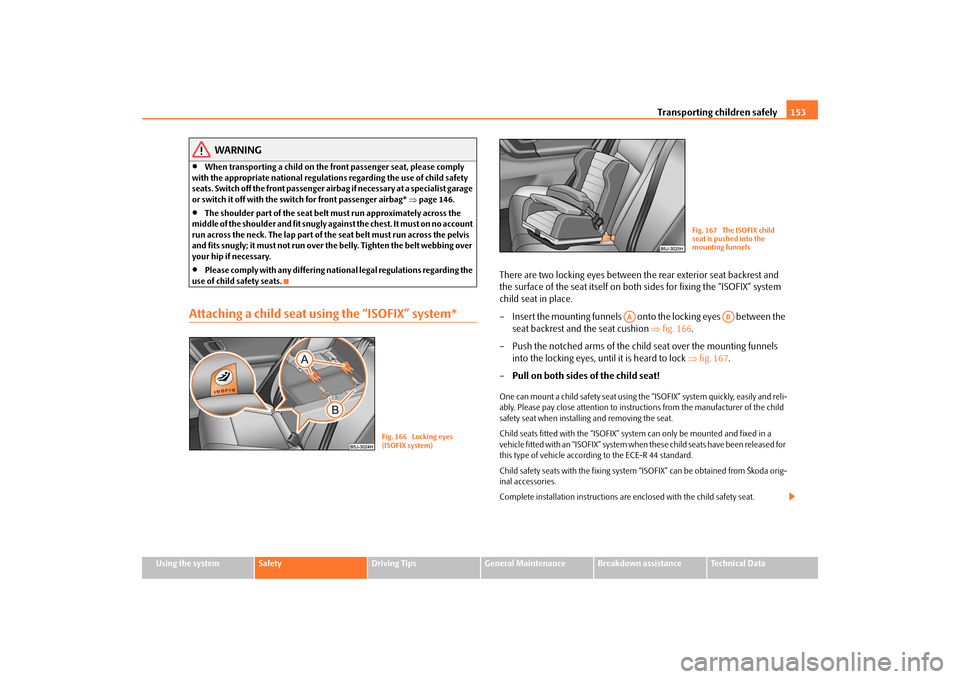
Transporting children safely153
Using the system
Safety
Driving Tips
General Maintenance
Breakdown assistance
Technical Data
WARNING
•
When transporting a child on the front passenger seat, please comply
with the appropriate national regulations regarding the use of child safety
seats. Switch off the front passenger airbag if necessary at a specialist garage
or switch it off with the switch for front passenger airbag* ⇒page 146.
•
The shoulder part of the seat belt must run approximately across the
middle of the shoulder and fit snugly against the chest. It must on no account
run across the neck. The lap part of the seat belt must run across the pelvis
and fits snugly; it must not run over the belly. Tighten the belt webbing over
your hip if necessary.
•
Please comply with any differing national legal regulations regarding the
use of child safety seats.
Attaching a child seat using the “ISOFIX” system*
There are two locking eyes between the rear exterior seat backrest and
the surface of the seat itself on both sides for fixing the “ISOFIX” system
child seat in place.
– Insert the mounting funnels onto the locking eyes between the
seat backrest and the seat cushion ⇒fig. 166.
– Push the notched arms of the child seat over the mounting funnels
into the locking eyes, until it is heard to lock ⇒fig. 167.
–Pull on both sides of the child seat!One can mount a child safety seat using the “ISOFIX” system quickly, easily and reli-
ably. Please pay close attention to instructions from the manufacturer of the child
safety seat when installing and removing the seat.
Child seats fitted with the “ISOFIX” system can only be mounted and fixed in a
vehicle fitted with an “ISOFIX” system when these child seats have been released for
this type of vehicle according to the ECE-R 44 standard.
Child safety seats with the fixing system “ISOFIX” can be obtained from Škoda orig-
inal accessories.
Complete installation instructions are enclosed with the child safety seat.
Fig. 166 Locking eyes
(ISOFIX system)
Fig. 167 The ISOFIX child
seat is pushed into the
mounting funnels
AA
AB
s3f4.1.book Page 153 Thursday, June 18, 2009 11:07 AM
Page 155 of 259
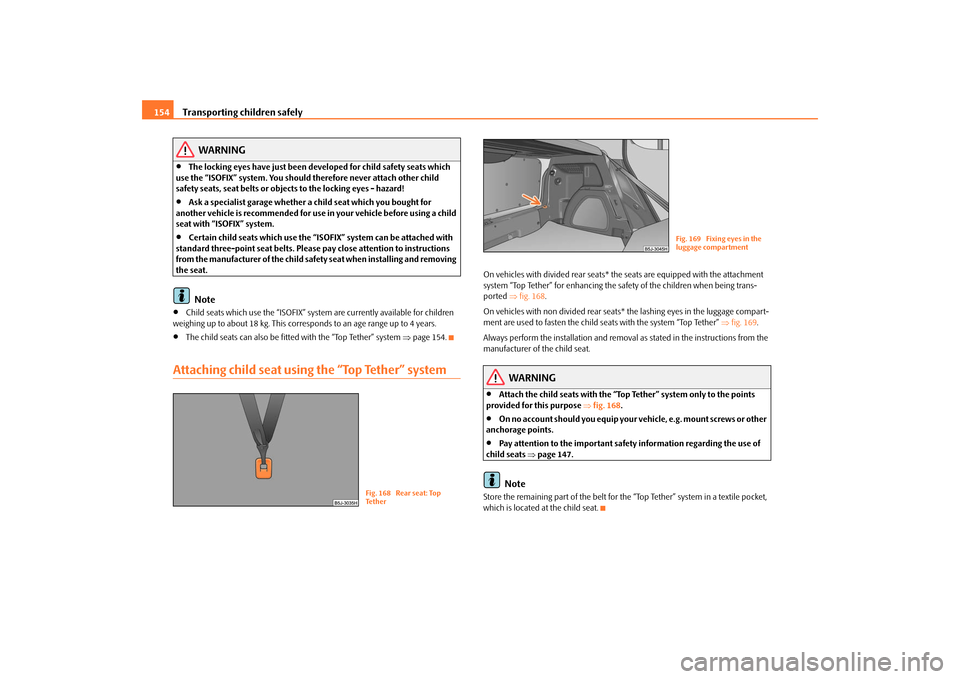
Transporting children safely 154
WARNING
•
The locking eyes have just been developed for child safety seats which
use the “ISOFIX” system. You should therefore never attach other child
safety seats, seat belts or objects to the locking eyes - hazard!
•
Ask a specialist garage whether a child seat which you bought for
another vehicle is recommended for use in your vehicle before using a child
seat with “ISOFIX” system.
•
Certain child seats which use the “ISOFIX” system can be attached with
standard three-point seat belts. Please pay close attention to instructions
from the manufacturer of the child safety seat when installing and removing
the seat.Note
•
Child seats which use the “ISOFIX” system are currently available for children
weighing up to about 18 kg. This corresponds to an age range up to 4 years.
•
The child seats can also be fitted with the “Top Tether” system ⇒page 154.
Attaching child seat using the “Top Tether” system
On vehicles with divided rear seats* the seats are equipped with the attachment
system “Top Tether” for enhancing the safety of the children when being trans-
ported ⇒fig. 168.
On vehicles with non divided rear seats* the lashing eyes in the luggage compart-
ment are used to fasten the child seats with the system “Top Tether” ⇒fig. 169.
Always perform the installation and removal as stated in the instructions from the
manufacturer of the child seat.
WARNING
•
Attach the child seats with the “Top Tether” system only to the points
provided for this purpose ⇒fig. 168.
•
On no account should you equip your vehicle, e.g. mount screws or other
anchorage points.
•
Pay attention to the important safety information regarding the use of
child seats ⇒page 147.Note
Store the remaining part of the belt for the “Top Tether” system in a textile pocket,
which is located at the child seat.
Fig. 168 Rear seat: Top
Te t h e r
Fig. 169 Fixing eyes in the
luggage compartment
s3f4.1.book Page 154 Thursday, June 18, 2009 11:07 AM
Page 156 of 259
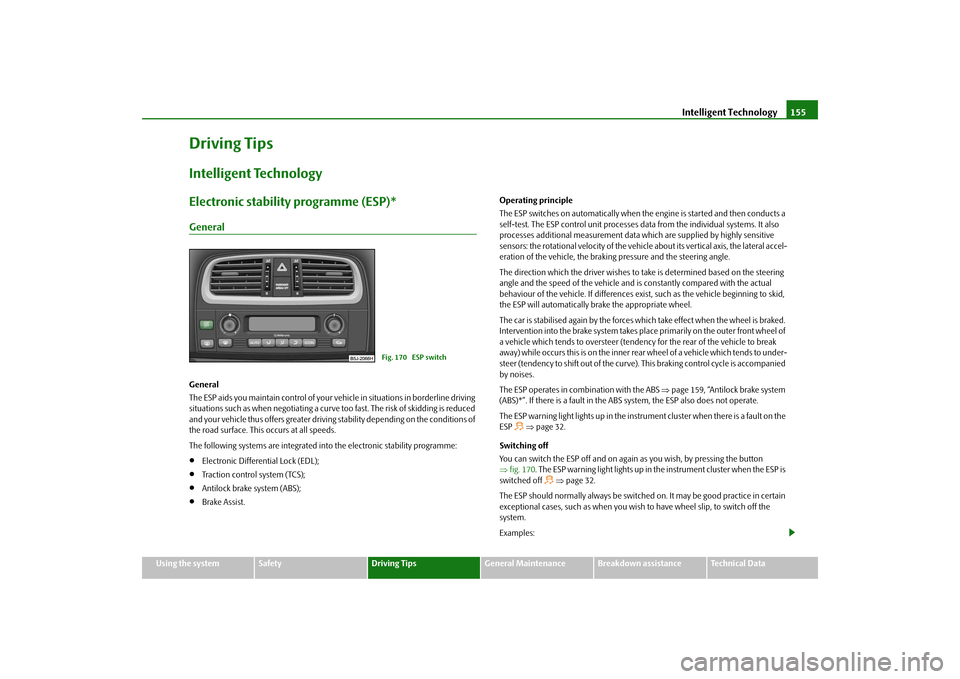
Intelligent Technology155
Using the system
Safety
Driving Tips
General Maintenance
Breakdown assistance
Technical Data
Driving TipsIntelligent TechnologyElectronic stability programme (ESP)*GeneralGeneral
The ESP aids you maintain control of your vehicle in situations in borderline driving
situations such as when negotiating a curve too fast. The risk of skidding is reduced
and your vehicle thus offers greater driving stability depending on the conditions of
the road surface. This occurs at all speeds.
The following systems are integrated into the electronic stability programme:•
Electronic Differential Lock (EDL);
•
Traction control system (TCS);
•
Antilock brake system (ABS);
•
Brake Assist.Operating principle
The ESP switches on automatically when the engine is started and then conducts a
self-test. The ESP control unit processes data from the individual systems. It also
processes additional measurement data which are supplied by highly sensitive
sensors: the rotational velocity of the vehicle about its vertical axis, the lateral accel-
eration of the vehicle, the braking pressure and the steering angle.
The direction which the driver wishes to take is determined based on the steering
angle and the speed of the vehicle and is constantly compared with the actual
behaviour of the vehicle. If differences exist, such as the vehicle beginning to skid,
the ESP will automatically brake the appropriate wheel.
The car is stabilised again by the forces which take effect when the wheel is braked.
Intervention into the brake system takes place primarily on the outer front wheel of
a vehicle which tends to oversteer (tendency for the rear of the vehicle to break
away) while occurs this is on the inner rear wheel of a vehicle which tends to under-
steer (tendency to shift out of the curve). This braking control cycle is accompanied
by noises.
The ESP operates in combination with the ABS ⇒page 159, “Antilock brake system
(ABS)*”. If there is a fault in the ABS system, the ESP also does not operate.
The ESP warning light lights up in the instrument cluster when there is a fault on the
ESP
⇒page 32.
Switching off
You can switch the ESP off and on again as you wish, by pressing the button
⇒fig. 170. The ESP warning light lights up in the instrument cluster when the ESP is
switched off
⇒page 32.
The ESP should normally always be switched on. It may be good practice in certain
exceptional cases, such as when you wish to have wheel slip, to switch off the
system.
Examples:
Fig. 170 ESP switch
s3f4.1.book Page 155 Thursday, June 18, 2009 11:07 AM
Page 157 of 259
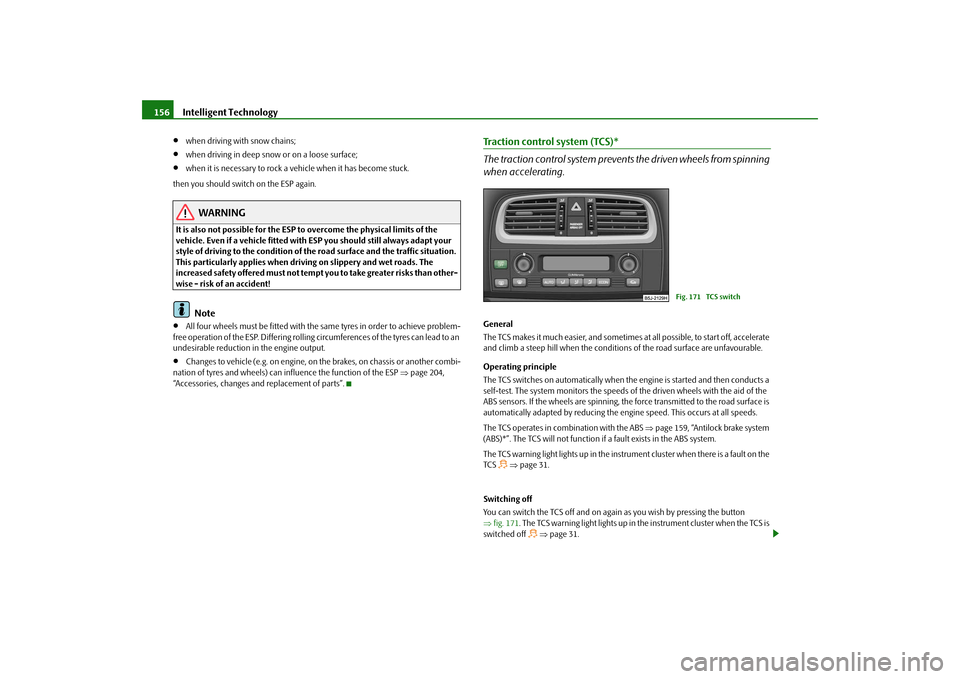
Intelligent Technology 156•
when driving with snow chains;
•
when driving in deep snow or on a loose surface;
•
when it is necessary to rock a vehicle when it has become stuck.
then you should switch on the ESP again.
WARNING
It is also not possible for the ESP to overcome the physical limits of the
vehicle. Even if a vehicle fitted with ESP you should still always adapt your
style of driving to the condition of the road surface and the traffic situation.
This particularly applies when driving on slippery and wet roads. The
increased safety offered must not tempt you to take greater risks than other-
wise - risk of an accident!
Note
•
All four wheels must be fitted with the same tyres in order to achieve problem-
free operation of the ESP. Differing rolling circumferences of the tyres can lead to an
undesirable reduction in the engine output.
•
Changes to vehicle (e.g. on engine, on the brakes, on chassis or another combi-
nation of tyres and wheels) can influence the function of the ESP ⇒page 204,
“Accessories, changes and replacement of parts”.
Traction control system (TCS)*
The traction control system prevents the driven wheels from spinning
when accelerating.General
The TCS makes it much easier, and sometimes at all possible, to start off, accelerate
and climb a steep hill when the conditions of the road surface are unfavourable.
Operating principle
The TCS switches on automatically when the engine is started and then conducts a
self-test. The system monitors the speeds of the driven wheels with the aid of the
ABS sensors. If the wheels are spinning, the force transmitted to the road surface is
automatically adapted by reducing the engine speed. This occurs at all speeds.
The TCS operates in combination with the ABS ⇒page 159, “Antilock brake system
(ABS)*”. The TCS will not function if a fault exists in the ABS system.
The TCS warning light lights up in the instrument cluster when there is a fault on the
TCS
⇒page 31.
Switching off
You can switch the TCS off and on again as you wish by pressing the button
⇒fig. 171. The TCS warning light lights up in the instrument cluster when the TCS is
switched off
⇒page 31.
Fig. 171 TCS switch
s3f4.1.book Page 156 Thursday, June 18, 2009 11:07 AM
Page 158 of 259
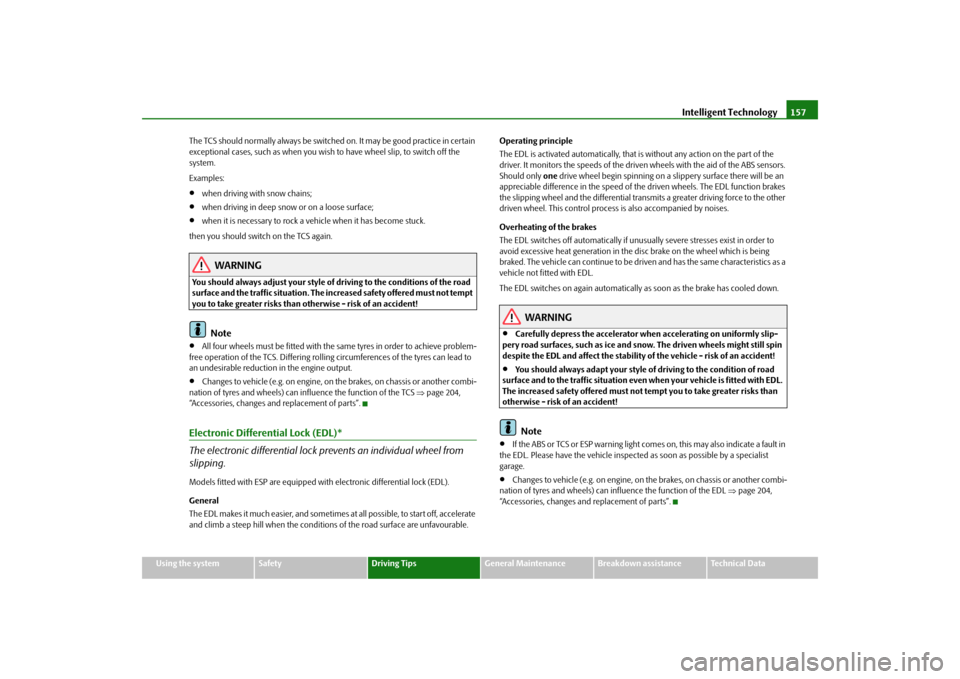
Intelligent Technology157
Using the system
Safety
Driving Tips
General Maintenance
Breakdown assistance
Technical Data The TCS should normally always be switched on. It may be good practice in certain
exceptional cases, such as when you wish to have wheel slip, to switch off the
system.
Examples:
•
when driving with snow chains;
•
when driving in deep snow or on a loose surface;
•
when it is necessary to rock a vehicle when it has become stuck.
then you should switch on the TCS again.
WARNING
You should always adjust your style of driving to the conditions of the road
surface and the traffic situation. The increased safety offered must not tempt
you to take greater risks than otherwise - risk of an accident!
Note
•
All four wheels must be fitted with the same tyres in order to achieve problem-
free operation of the TCS. Differing rolling circumferences of the tyres can lead to
an undesirable reduction in the engine output.
•
Changes to vehicle (e.g. on engine, on the brakes, on chassis or another combi-
nation of tyres and wheels) can influence the function of the TCS ⇒page 204,
“Accessories, changes and replacement of parts”.
Electronic Differential Lock (EDL)*
The electronic differential lock prevents an individual wheel from
slipping.Models fitted with ESP are equipped with electronic differential lock (EDL).
General
The EDL makes it much easier, and sometimes at all possible, to start off, accelerate
and climb a steep hill when the conditions of the road surface are unfavourable.Operating principle
The EDL is activated automatically, that is without any action on the part of the
driver. It monitors the speeds of the driven wheels with the aid of the ABS sensors.
Should only one drive wheel begin spinning on a slippery surface there will be an
appreciable difference in the speed of the driven wheels. The EDL function brakes
the slipping wheel and the differential transmits a greater driving force to the other
driven wheel. This control process is also accompanied by noises.
Overheating of the brakes
The EDL switches off automatically if unusually severe stresses exist in order to
avoid excessive heat generation in the disc brake on the wheel which is being
braked. The vehicle can continue to be driven and has the same characteristics as a
vehicle not fitted with EDL.
The EDL switches on again automatically as soon as the brake has cooled down.
WARNING
•
Carefully depress the accelerator when accelerating on uniformly slip-
pery road surfaces, such as ice and snow. The driven wheels might still spin
despite the EDL and affect the stability of the vehicle - risk of an accident!
•
You should always adapt your style of driving to the condition of road
surface and to the traffic situation even when your vehicle is fitted with EDL.
The increased safety offered must not tempt you to take greater risks than
otherwise - risk of an accident!Note
•
If the ABS or TCS or ESP warning light comes on, this may also indicate a fault in
the EDL. Please have the vehicle inspected as soon as possible by a specialist
garage.
•
Changes to vehicle (e.g. on engine, on the brakes, on chassis or another combi-
nation of tyres and wheels) can influence the function of the EDL ⇒page 204,
“Accessories, changes and replacement of parts”.
s3f4.1.book Page 157 Thursday, June 18, 2009 11:07 AM
Page 159 of 259
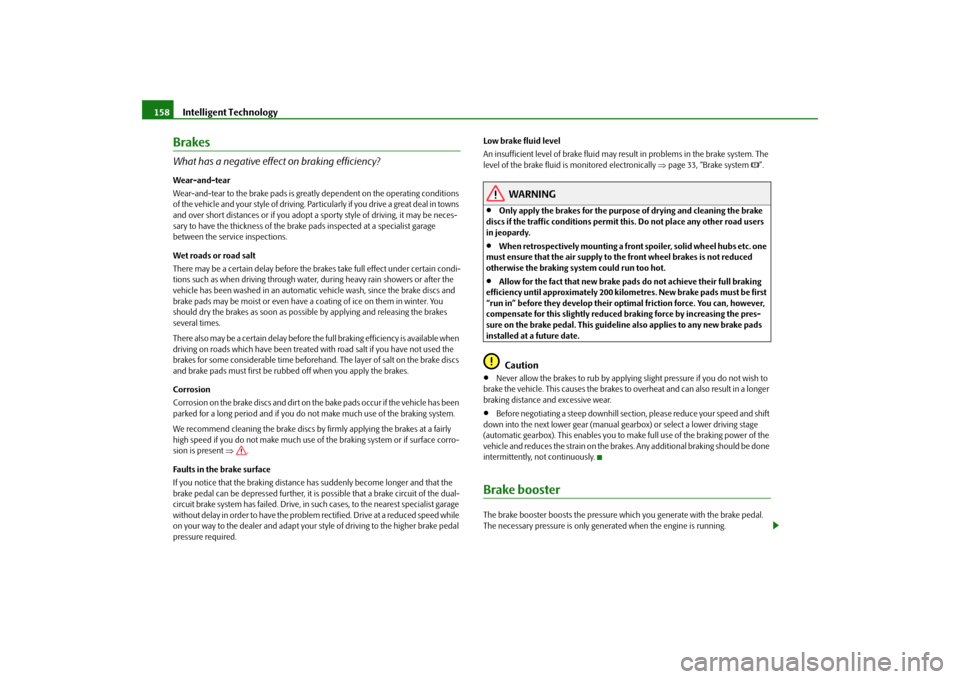
Intelligent Technology 158BrakesWhat has a negative effect on braking efficiency?Wear-and-tear
Wear-and-tear to the brake pads is greatly dependent on the operating conditions
of the vehicle and your style of driving. Particularly if you drive a great deal in towns
and over short distances or if you adopt a sporty style of driving, it may be neces-
sary to have the thickness of the brake pads inspected at a specialist garage
between the service inspections.
Wet roads or road salt
There may be a certain delay before the brakes take full effect under certain condi-
tions such as when driving through water, during heavy rain showers or after the
vehicle has been washed in an automatic vehicle wash, since the brake discs and
brake pads may be moist or even have a coating of ice on them in winter. You
should dry the brakes as soon as possible by applying and releasing the brakes
several times.
There also may be a certain delay before the full braking efficiency is available when
driving on roads which have been treated with road salt if you have not used the
brakes for some considerable time beforehand. The layer of salt on the brake discs
and brake pads must first be rubbed off when you apply the brakes.
Corrosion
Corrosion on the brake discs and dirt on the bake pads occur if the vehicle has been
parked for a long period and if you do not make much use of the braking system.
We recommend cleaning the brake discs by firmly applying the brakes at a fairly
high speed if you do not make much use of the braking system or if surface corro-
sion is present ⇒.
Faults in the brake surface
If you notice that the braking distance has suddenly become longer and that the
brake pedal can be depressed further, it is possible that a brake circuit of the dual-
circuit brake system has failed. Drive, in such cases, to the nearest specialist garage
without delay in order to have the problem rectified. Drive at a reduced speed while
on your way to the dealer and adapt your style of driving to the higher brake pedal
pressure required.Low brake fluid level
An insufficient level of brake fluid may result in problems in the brake system. The
level of the brake fluid is monitored electronically ⇒page 33, “Brake system ”.
WARNING
•
Only apply the brakes for the purpose of drying and cleaning the brake
discs if the traffic conditions permit this. Do not place any other road users
in jeopardy.
•
When retrospectively mounting a front spoiler, solid wheel hubs etc. one
must ensure that the air supply to the front wheel brakes is not reduced
otherwise the braking system could run too hot.
•
Allow for the fact that new brake pads do not achieve their full braking
efficiency until approximately 200 kilometres. New brake pads must be first
“run in” before they develop their optimal friction force. You can, however,
compensate for this slightly reduced braking force by increasing the pres-
sure on the brake pedal. This guideline also applies to any new brake pads
installed at a future date.Caution
•
Never allow the brakes to rub by applying slight pressure if you do not wish to
brake the vehicle. This causes the brakes to overheat and can also result in a longer
braking distance and excessive wear.
•
Before negotiating a steep downhill section, please reduce your speed and shift
down into the next lower gear (manual gearbox) or select a lower driving stage
(automatic gearbox). This enables you to make full use of the braking power of the
vehicle and reduces the strain on the brakes. Any additional braking should be done
intermittently, not continuously.
Brake boosterThe brake booster boosts the pressure which you generate with the brake pedal.
The necessary pressure is only generated when the engine is running.
s3f4.1.book Page 158 Thursday, June 18, 2009 11:07 AM
Page 160 of 259
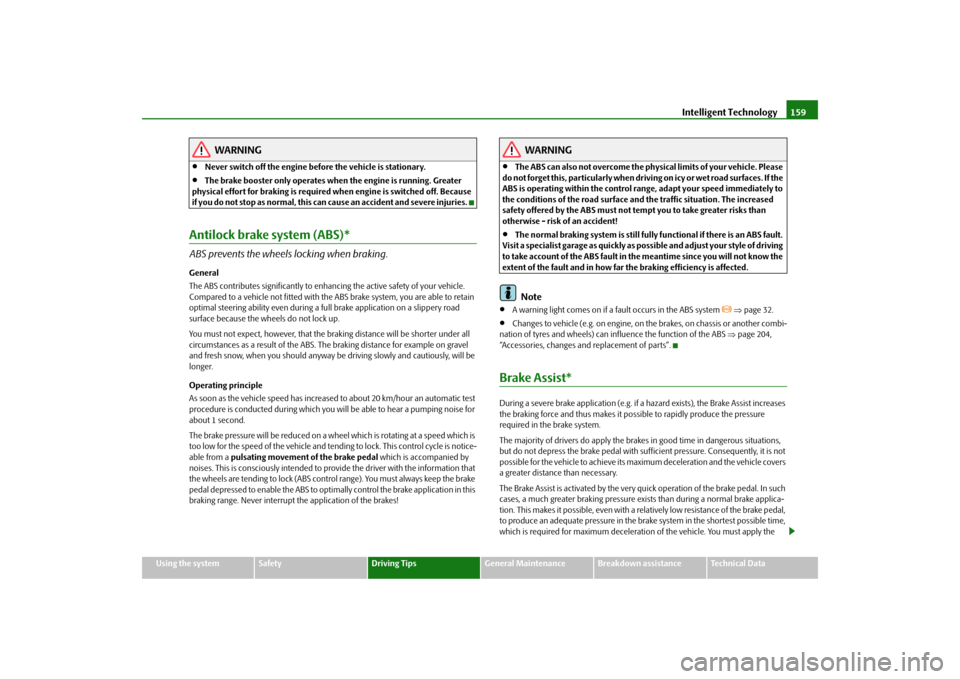
Intelligent Technology159
Using the system
Safety
Driving Tips
General Maintenance
Breakdown assistance
Technical Data
WARNING
•
Never switch off the engine before the vehicle is stationary.
•
The brake booster only operates when the engine is running. Greater
physical effort for braking is required when engine is switched off. Because
if you do not stop as normal, this can cause an accident and severe injuries.
Antilock brake system (ABS)*ABS prevents the wheels locking when braking.General
The ABS contributes significantly to enhancing the active safety of your vehicle.
Compared to a vehicle not fitted with the ABS brake system, you are able to retain
optimal steering ability even during a full brake application on a slippery road
surface because the wheels do not lock up.
You must not expect, however, that the braking distance will be shorter under all
circumstances as a result of the ABS. The braking distance for example on gravel
and fresh snow, when you should anyway be driving slowly and cautiously, will be
longer.
Operating principle
As soon as the vehicle speed has increased to about 20 km/hour an automatic test
procedure is conducted during which you will be able to hear a pumping noise for
about 1 second.
The brake pressure will be reduced on a wheel which is rotating at a speed which is
too low for the speed of the vehicle and tending to lock. This control cycle is notice-
able from a pulsating movement of the brake pedal which is accompanied by
noises. This is consciously intended to provide the driver with the information that
the wheels are tending to lock (ABS control range). You must always keep the brake
pedal depressed to enable the ABS to optimally control the brake application in this
braking range. Never interrupt the application of the brakes!
WARNING
•
The ABS can also not overcome the physical limits of your vehicle. Please
do not forget this, particularly when driving on icy or wet road surfaces. If the
ABS is operating within the control range, adapt your speed immediately to
the conditions of the road surface and the traffic situation. The increased
safety offered by the ABS must not tempt you to take greater risks than
otherwise - risk of an accident!
•
The normal braking system is still fully functional if there is an ABS fault.
Visit a specialist garage as quickly as possible and adjust your style of driving
to take account of the ABS fault in the meantime since you will not know the
extent of the fault and in how far the braking efficiency is affected.Note
•
A warning light comes on if a fault occurs in the ABS system
⇒page 32.
•
Changes to vehicle (e.g. on engine, on the brakes, on chassis or another combi-
nation of tyres and wheels) can influence the function of the ABS ⇒page 204,
“Accessories, changes and replacement of parts”.
Brake Assist*During a severe brake application (e.g. if a hazard exists), the Brake Assist increases
the braking force and thus makes it possible to rapidly produce the pressure
required in the brake system.
The majority of drivers do apply the brakes in good time in dangerous situations,
but do not depress the brake pedal with sufficient pressure. Consequently, it is not
possible for the vehicle to achieve its maximum deceleration and the vehicle covers
a greater distance than necessary.
The Brake Assist is activated by the very quick operation of the brake pedal. In such
cases, a much greater braking pressure exists than during a normal brake applica-
tion. This makes it possible, even with a relatively low resistance of the brake pedal,
to produce an adequate pressure in the brake system in the shortest possible time,
which is required for maximum deceleration of the vehicle. You must apply the
s3f4.1.book Page 159 Thursday, June 18, 2009 11:07 AM